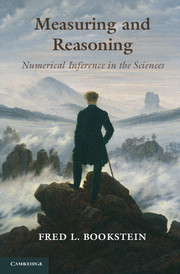Book contents
- Frontmatter
- Dedication
- Contents
- Analytical Table of Contents
- Preface
- Epigraphs
- Part I The Basic Structure of Numerical Inference
- Part II A Sampler of Strategies
- Part III Numerical Inference for General Systems
- 5 Abduction and Consilience in More complicated Systems
- 6 The Singular-Value Decomposition: A Family of Pattern Engines for Organized Systems
- 7 Morphometrics, and Other Examples
- Part IV What Is to Be Done?
- References
- Index
- Plate section
7 - Morphometrics, and Other Examples
from Part III - Numerical Inference for General Systems
Published online by Cambridge University Press: 05 March 2014
- Frontmatter
- Dedication
- Contents
- Analytical Table of Contents
- Preface
- Epigraphs
- Part I The Basic Structure of Numerical Inference
- Part II A Sampler of Strategies
- Part III Numerical Inference for General Systems
- 5 Abduction and Consilience in More complicated Systems
- 6 The Singular-Value Decomposition: A Family of Pattern Engines for Organized Systems
- 7 Morphometrics, and Other Examples
- Part IV What Is to Be Done?
- References
- Index
- Plate section
Summary
Biological forms are particularly highly organized systems. Here in 2013, morphometries is the careful construction of a framework for quantification of these systems that supports pattern analyses over pointlike, curvelike, or surfacelike image data represented in ways that highlight their organized aspects. Beyond all the geometry, its methods align well with the toolkit introduced in the previous chapter, the singular-value decomposition (SVD) in its three different guises. But the applications context for these tools has been optimized by massive intellectual investment in the structure of variables a priori, a strategy aligned with the criteria of Section 6.3.2 about where good sets of measurements come from. Morphometrics is my favorite example of the real work actually involved in setting up that numerical information from images of living or once-living creatures, so as to be fully open to both abduction (surprise) and consilience (confirmation by measurements via other quantitative protocols).
Right at the core of morphometrics is a particularly careful construal of what we mean by “shape measurement” – how raw information from images of living or once-living creatures, modulated by the installed knowledge base of comparative anatomy, is transformed into the geometry and algebra that allow us to pursue the theories and explanations that govern this domain of organized form. This process, the rearrangement of intuitive turn-of-the-20th-century ideas of biometrics so as to suit modern approaches to numerical inference in organized systems, culminated only recently, from 1980 through 2005 or so, in the hands of the present author in collaboration with a range of colleagues including W. D. K. Green, James Rohlf, Kanti Mardia, John Kent, Dennis Slice, and Paul O'Higgins.
- Type
- Chapter
- Information
- Measuring and ReasoningNumerical Inference in the Sciences, pp. 402 - 478Publisher: Cambridge University PressPrint publication year: 2014



